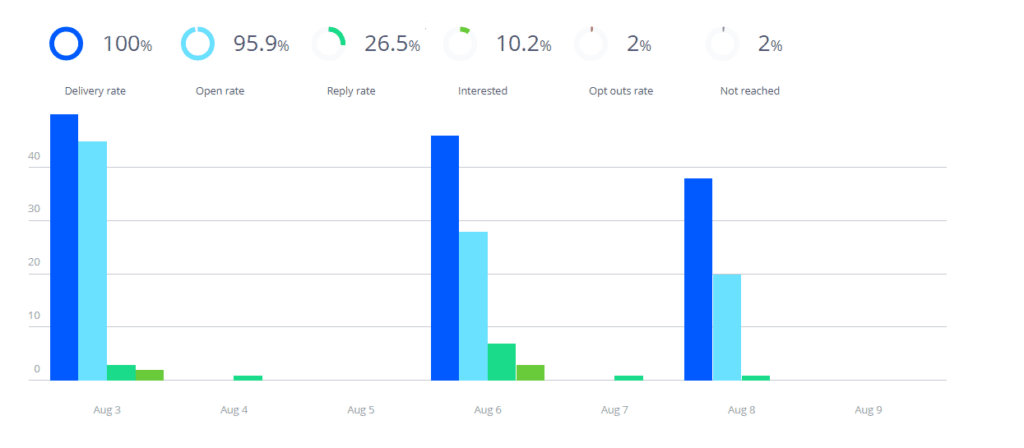
How Reply helps SalesHive get an 80% open rate
84 %
Open rate
25 %
Response rate

Brendan Burnett
Co-founder & CEOFrom SaaS to Services, SalesHive leverages the latest multichannel prospecting strategies and technologies to set highly qualified meetings and create predictable revenue for growing B2B companies.
saleshive.comAgencies
 Brendan Burnett
Brendan Burnett
Brendan founded SalesHive to help entrepreneurs and growing B2B companies accelerate pipeline growth by providing sales development experts to execute sales outreach at a fraction of the cost and time.
SalesHIve is a sales development company, helping technology companies and other service businesses set up meetings and sell their products.
We do this by reaching out to their target industries, identifying target prospects and then sending out targeted value proposition emails in order to promote interest in different products and services.
Currently, we do outbound marketing and sales for over 40 SaaS and B2B service companies.
Finding the right channel
Email automation is the core of our business, but we also use different channels, including LinkedIn and direct mail. There’s a perfect channel for every type of buyer. For sales and marketing, those people are always on LinkedIn, so that’s obviously going to be a great channel for you if they’re your target market.
When it comes to inbound/outbound, email will inherently always drive inbound traffic. Usually, the first thing someone does when they see your cold email is visit your website. If the website is for something you can sign up for online, such as Reply, they may go ahead and sign up for it right there.
That would be technically an inbound lead because they signed up on your website. But they got to your website as a result of an outbound email campaign. That’s one of the most difficult parts of lead attribution; do I put that into my website conversions or is that an outbound conversion? In my opinion, that’d be an outbound conversion.
For our campaigns, we like to do three months on and three months off. So sometimes we’ll alternate with LinkedIn for three months, then we’ll do email for three months, and maybe mix in some direct mail throughout the entire process, along with advertising. We like to always be in touch with our prospects in some sort of way.
Nailing that first email
As we’re responsible for the outbound marketing of a lot of companies, we get to see a lot of good (and bad) examples of emails. People sending cold emails commonly try too hard on the first email.
The first email is just an introduction. For example, if you’re hitting on a girl you wouldn’t tell your life story, or who you are, where you went to college, all when you introduce yourself. It’s very similar to cold email.
The first email you want to pique interest or set common ground—maybe use some flattery. But the best thing you can do is create context for why you’re reaching out.
The CEO of Nike is getting a thousand emails a day. His inbox is probably managed by his secretary and she’s used to seeing these emails come through about ‘we do this, we do that, blah blah blah.’ So it’s super important to keep it brief. Some first emails we send are one sentence long and just create some context, create the start of a relationship.
Many people don’t realize the emails they send are triggering spam filters because of the words they’re using. For example, imagine you’re selling marketing software. You’re talking about how “we’ll help you improve your marketing and generate more sales by using our sales intelligence engine/platform.”
That’s a very common cold email. The word ‘sales’—used twice in that email—is a spam trigger keyword. The word ‘marketing’ is a spam trigger keyword. I bet that email also has an image of the company’s logo, which means more HTML and increases the likelihood of going to spam.
Open tracking doesn’t help. That’s one of the funniest parts about open tracking: You’ll end up with fewer opens because of the nature of having an open tracking tag in your email. Ironic. So once you’ve optimized your subject lines, I would remove the open tracking and stick to tracking replies.
How to create context in your emails
Say you have 500 prospects in Denver. You can do customization on a mass scale by sending them an email cadence referencing the Denver Broncos football team: “Hey, did you catch the Broncos game yesterday?”
Most people write emails like “Hey, I saw you’re in sales and we sell sales technology to salespeople,” and then insert some generic value proposition. A lot of emails are very obvious now and spam triggers are getting more sensitive and smarter. There’s plenty of ways to create context like “Hey, thanks for accepting my LinkedIn request.” Now you’re a networker, not just some random, cold email salesperson.
You can take it a step further with direct mail; sending someone a bottle of wine and following up to see if they received it is always a great way to create context.
If I sent you something and ask did you get it, that’s a lot more effective than saying “Take a meeting with me and I’ll send you a bottle of wine.”
There are lots of different ways to create context and I think that’s the most challenging part with email marketing; creating some sort of connection between you and the prospect and still being able to do it at scale. So talking about sports or what college they went to, or the city they’re in, or the latest news in the industry—those are more scalable things.
At the other end of the scale, you have triggers, which aren’t scalable. There are specific triggers you can still use in email marketing, for example, when someone just got hired at a company. You can congratulate them and open up the conversation that way: “Congrats on the new gig.” That’s an interesting way to start a conversation.
There’s new technology as well where you can see buyer intent for specific types of software, or you can see who’s been on your website. You can send an email that says: “Hey, I saw someone from your company was visiting our website. I wanted to make an introduction and see if I can answer any questions.” These are all types of ways to create the context that isn’t: “Hey I have a piece of software that I’d like to sell you.”
Crafting the ideal subject line
An ideal subject should be catchy. A lot of people try to be salesy, but I like to be a little more sneaky and make it look like a subject line that someone you know might send.
For example, look at the subject lines your boss has sent to you. Then, on the opposite side, look at the subject lines sales reps are sending you. I guarantee, just by scanning the subject lines, you’ll be able to know “Oh this is important, I should open this email,” vs “This is obviously some random sales guy trying to take up my time.” Often I try to make it something that someone close to me would write. This ends up being typically shorter than most sales email subject lines and doesn’t contain a question.
A lot of techniques that worked six months ago don’t work today. That’s one of the biggest challenges and one of the most fun parts about email marketing: continually outsmarting yourself and outsmarting the industry. Continue improving your messaging. You can’t send the same message to everyone, every time. Other marketers pick up on the techniques that work, so there’ll be people reading this who immediately start sending everyone wine. You have to be 10 steps ahead and already onto the next trick.
The two steps to email marketing success
Our biggest advantage is we believe in selling great software to people that need it and who are going to see a positive ROI. That’s what email marketing is all about.
There’s a fine line between spam and outbound email marketing or sales, a very fine line. First of all, you need to take the time to build the right list. You could have the best messaging, the best product/service, but if you’re emailing a bunch of people that would never buy your product in a million years—that’s spam. The first step is to have the right audience:
- Are these people who could potentially be successful clients of ours?
- Are these people that could benefit from using our software?
- Would these people buy our software?
If not then everything else is worthless. The second step to email marketing is finding their contact information and validating it. Reply has that built into the software and that’s great. But we use two different sources (Reply and another validation platform) to make sure we’re not sending emails to a bunch of invalid addresses and hurting our email domain.
I used to run sales devolvement for a very large company and at one point we were sending lots of emails when the domain got flagged. It was a disaster.
Nurturing your prospects and sending them content is always good, but you have to be careful with spam. When you’re sending out links and attachments (particularly through a platform like Reply that’s tracking open rates and clicks), emails can easily be triggered as spam.
It can be as simple as a spelling error in your email, or forgetting the merge tag, and people start marking you as spam. If 20-30 people mark you as spam, your domain may get hurt irreversibly. To make sure that doesn’t happen, we always create an email marketing domain. In the event anything ever happens to our domain, it’s not our main company domain. We never use our company domain for email marketing.
The worst thing to happen is your CEO tries to send your top client an email and it goes to spam (and yes, that’s happened to me before).
Using events to boost your open and reply rates
Our most successful campaigns are based around events. We find events that our target market is going to and, even if we’re not attending, we still send emails about them. People are getting excited about these events. They’re making their travel plans and trying to set meetings for the events to pretend they’re being productive (when really they’re probably just drinking).
If you’re looking for high open and reply rates, doing a campaign around a big industry event, or an event in your area, or even trying to set up a meeting of the minds between CEOs in your area can all be highly impactful.
We’ve had open rates of 80 percent this way. There’s also one metric our company tracks that no one else tracks: we call it the open-to-reply percentage.
Imagine you had a 5 percent open rate, but your email copy—which determines whether people reply—was incredible and 100 percent of the people that open the email reply. You have a terrible subject line, but all those people who opened the email reply; you’re still going to have a low reply percentage. So when we’re looking at reply percentage, we always do so as a percentage of open rate. We actually don’t track reply percentage, we track open-to-reply, so we can truly judge the effectiveness of the copy inside of the e-mail.
A solution for multiple clients
We were already using an email automation solution, but we realized we needed additional features. For example, as an agency with multiple clients, it was important to be able to easily and clearly separate their data. Reply is set up so each individual license can have its own database, or you can set it to have a shared database. This kind of flexibility really helped.
Switching to Reply also saved us money. The biggest saving was being able to add multiple email addresses per account. So instead of having to buy licenses for each different email address, we were able to save costs by adding up to five email addresses per user account.
We use Reply for getting our own leads as well as providing services for our clients. We have accounts strategists that manage the campaigns, responders that respond to the campaigns, a dedicated research team finding the right contacts; we even have a team dedicated fulltime to managing all our instances of Reply.
While we’ve used other email automation solutions before, Reply offers great value for the price. We’ve used their API connection to automate our reporting, which is great, and they continue to reinvest in the platform.
If you’re a B2B company looking to outsource your sales development, you can learn more about SalesHive and their services here.
Find out more about Reply’s features, how we can help automate your inbound and outbound sales, and sign up a 14-day free trial today

Other case studies






